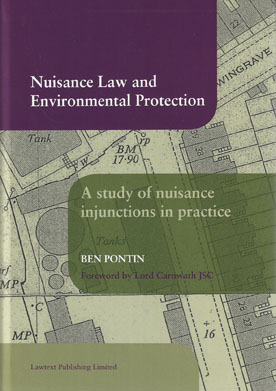[The first in a series of posts by
Ben Pontin:]
English nuisance law is a tort to land that has attracted considerable – some would say disproportionate - interest within circles of environmental law history. In
Coventry v Lawrence [2014] UKSC 13 (at [176]), Lord Carnwath commented on part of my contribution to the field as follows:
Ben Pontin in his valuable recent book Nuisance Law and Environmental Protection (2013) shows how since the middle of the 19th Century common law nuisance has played an important complementary role to regulatory controls, on the one hand stimulating industry to find better technical solutions to environmental problems, and, on the other, stimulating the legislature to fill gaps in the regulatory system. He sees the present appeal as an important opportunity for the Supreme Court to review the proper role of this part of the law of nuisance in the modern world. (p 184)
Coventry concerned the relationship between nuisance law and regulation, which is a topic that has been central to nuisance law history since the pioneering studies of Joel Brenner and John McLaren in the 1970s and 80s.
Brenner and McLaren argue in different ways to the conclusion that effective legal remedies for revolutionary pollution awaited statutory regulation later in the nineteenth century. Prior reliance on nuisance law, as it had evolved since antiquity, substantially (so the argument goes) failed to remedy industrialisation’s legendary ‘monster nuisances’. The explanation for nuisance law’s weakness provided by Brenner lies with courts moving away from ‘pre-industrial’ strict liability to favour the ‘wealth generating polluter’ in their disputes with neighbours seeking to protect their property and its amenity (Brenner,
‘Nuisance Law and the Industrial Revolution’ (1974) Journal of Legal Studies 403). McLaren’s explanation differs in its focus on litigation costs and similar ‘institutional’ limits of nuisance law in the face of the vast scale of industrial pollution (McLaren,
‘Nuisance Law and the Industrial Revolution – Some Lessons from Social History’ (1983) Oxford Journal of Legal Studies 155).
 |
The Chancery Court claim in
AG v Birmingham |
By contrast, my book offers a revised portrayal of nuisance law, as a success. It does so with reference to a small selection of in-depth case studies of specific instances of industrial nuisance litigation, beginning with
Attorney General v Birmingham Corporation (1858) 4 K & J 528. Contextual records relating to the litigation underpinning this case reveal some intriguing events, and ultimately a remarkable practical achievement. Over the course of forty years of litigation, affecting hundreds of thousands of people, involving tens of millions of pounds of investment (on today’s currency calculation), the enjoined municipal defendant invented and adopted a sewage purification technology that satisfied the plaintiff (Sir Charles Bowyer Adderley) and led to the injunction’s lifting. The case inspired others to litigate sewage pollution, and thus it is understandable that Lord Robert Carnwath (again) in a recent article refers to the ‘Great Birmingham Sewage Case’ (in
‘Judges and the Common Laws of the Environment – at Home and Abroad’ (2014)
Journal of Environmental Law doi: 10.1093/jel/equ009).
‘Great’ litigation in this and other fields of industrial pollution cannot be divorced from its complex social and economic backdrop, characterised by a territorial elite under threat from capitalism reinventing itself as a the nation’s guardian of ‘Nature’s treasures’. How gothic revivalism shaped nuisance law’s achievements is the subject of
a blog to follow.
What was often at issue was not property, supported by law, against no-property; It was alternative definitions of property-rights: for the landowner, enclosure; for the cottager, common rights; for the forest officialdom, ‘preserved grounds’ for the deer; for the foresters, the right to take turfs. For as long as it remained possible, the ruled––if they could find a purse and a lawyer––would actually fight for their rights by means of law; occasionally the copyholders, resting upon the precedents of sixteenth-century law, could actually win a case.












